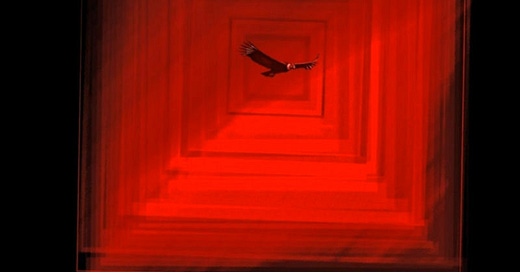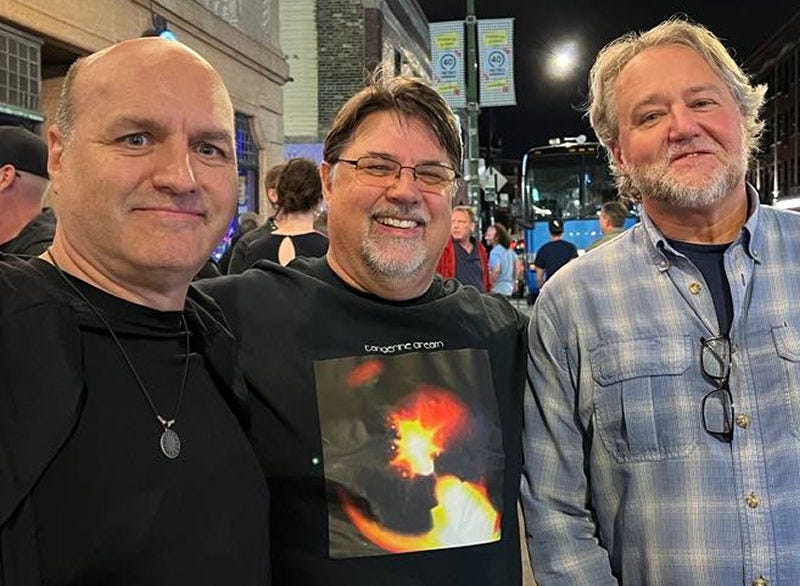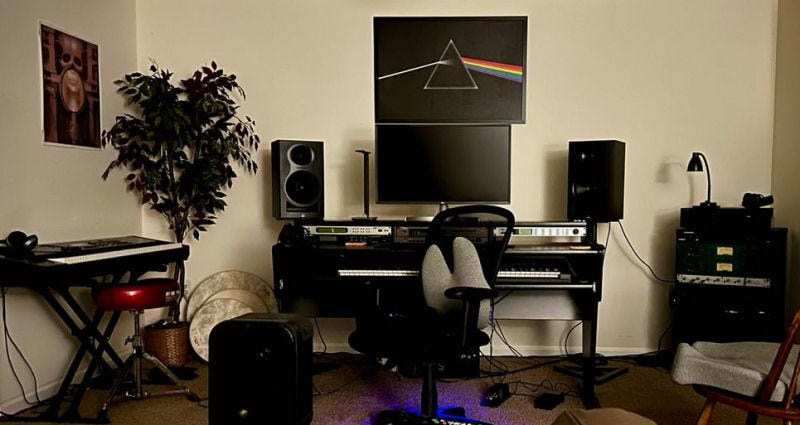Welcome back. The following is the continuation of my interview with songwriters and musicians, Jim Pietkivitch and Steve Hysjulien on their new album, “Morrow”.
[IMAGE: “Steve on right and our friend Craig Kroll on the left at a Tangerine Dream concert last October in Chicago”. ~ Jim.]
On with the interview:
Dave: “What keyboards, drums, other instruments are you using to create and record the music - and what is your DAW preference?”
Jim: “On “Morrow”, I used PreSonus Studio One DAW but have used Cakewalk and Cubase. I play a Yamaha S90 ES fully weighted 88-note keyboard and a Roland Fantom 7 76-note keyboard as my main instruments. The Fantom 7 combines sample-playback, subtractive & wavetable synthesis, incorporates older Roland analog synths, and virtual piano for its tone generation. For soft synths on “Morrow”, I used the u-he Hive and Arturia Mellotron V and a host of plugin effects. I did not play any acoustic drums or my Roland V-Drums on the album. All drums were played on the keys by Steve and me. We used a mixture of sample-based drums from PreSonus to achieve desired rhythm and sound on the track Motion. The drums on “Morrow” are orchestral in nature. I have several older sound modules and a Yamaha SY99 keyboard I used on previous albums, but they are not currently in the lineup. Steve did pre-mastering on pieces he wrote but the final album was engineered and mastered at my studio. I had just set it up EQ’d the room and was getting used to all the new tools. I primarily used Izotope Ozone 10 suite for production and mastering. It took Steve and I about two months to complete. I have Kali Audio IM-8 V2 8-inch studio monitors and Kali Audio WS-12 V2 12-inch sub”.
Steve: “I primarily used Reaper along with PreSonus Studio One, installed on a laptop, when I was away from Reaper. An AKAI MPK261 was the MIDI controller mainly used as a keyboard for VSTs. Omnisphere, Vital, Decent Sampler, Audiolatry and Melda were mostly selected for synth and piano parts along with various 808 plug-ins for bass and kick tracks. Most of the guitar parts were directly recorded with a PreSonus BlueTube D2 preamp into an Audio Interface. Then Amp Sims or Pedal Modelers were used. Including plugins from Audio Assault, PRS from Waves, and Ampire along with a couple of free VST Tube Screamer and Rat pedal emulators. Soundtoys Echoboy, Baby Audio Magic Switch, Loades De-Esser and a free/simple Acon Reverb figured prominently on all the guitar tracks plus others. Vigil guitar parts were played via a Boss GT-6. Also worth mentioning that MIDI Guitar 2 was used for the synth chord progression on Dweller.
The Reaper master channel typically included Tokyo Dawn’s Nova, Kotelnikov and VOS SlickEQ (mid/side), Waves SSLComp along with Gullfoss and the Sonible Smart Limiter. The monitoring channel had a couple instances of Voxengo SPAN to watch of anomalies plus Sonible’s true;Balance, Sonarworks, Can Opener and a LUFS meter plugin”.
Dave: “Do you actually write the music or do you use a program like Sibelius?”
Jim: “I compose through playing mostly. I don’t hand write out music, but I use the DAW as a scratch pad, and then re-perform parts as needed for the final version. I prefer to record takes until I get them right vs editing in the DAW. However, in some areas, I will use the notation editor to help craft a melody. I will lightly quantize parts as needed. Sometimes, a strong quantize is used for the more electronic feel like on Motion. Both Steve and I want the best “feel” in the music and timing doesn’t have to be perfect. On “Motion”, we used a sequencer called Stepic where we randomize notes based on the chord progression which was used by Steve, but we picked the best randomized parts, meaning, the ones we thought were most musical, and put them in the right places in the piece. No AI was used. We do like to use the editing tools in the DAW which provides avenues of creativity not found anyplace else. Sequencers are very creative and handy in certain pieces or parts, but can’t capture the artist’s playing style or feel”.
Steve: “I totally agree with Jim’s observations, and I typically follow a very similar approach to developing new ideas. We did get the opportunity to ‘jam’ a few concepts when we first started a new section of a song; which is an awesome process to interact as musicians. It also enables new music directions to come into being. Jamming is a very special and strange part of music for me. As far as me sitting down and starting with a blank slate, usually, the less I get in the way and the more I respond to what develops, allows for more creative things to happen. That approach drove “Morrow” as individual sections and songs were created.
Regarding quantizing and perfection of music - it has its place as Jim mentioned, but is usually not a focus of mine. Elysium is a good example where there is a theme but not a recurring bridge/chorus/coda/etc. structure. I think with Elysium you get an emotional mood from the piece instead of a structured event that was perfected via the DAW and software tools. Having the music emanate as a live listening or human performance gives the music a feel and vibe that I think people hear as an emotional impression was captured. We both gravitate to that approach on most of “Morrow”. It is interesting collaborating with Jim’s background as a drummer, he can quickly go back and forth between the flow and timing musical worlds and that was very helpful as we shaped the music”.
Dave: “How can anyone access or purchase your music?”
Jim: “We released “Morrow” through CD Baby, which provides digital distribution through all the streaming music services like Spotify, Amazon Music, Apple Music, and YouTube. We are considering making a limited CD production or vinyl pressing.
Dave: “How many hours, days, weeks did it take to do this album?”
Jim: “That is hard to tell. Some are longer stretches of 20-30 hours a week when composing and mastering; but then there were some long breaks over the 2-year period of the project. At the beginning, Steve gave me 60 to 70 ideas, and I picked out several I liked and we started working with those. We spent lots of time listening. Some ideas were nearly finished and others rough ideas. The track “Daybreak”, which Steve called “B Minor Down”, was an acoustic guitar piece that I really liked. One evening after work I came up with my parts. I played bass pedals, piano, and strings. One more night doing a little better arrangement. That was it. Whereas, “Unfolding”, which I wrote, except for the beautiful guitar lead at the end, took several months to develop and get right. The first two sections of that song use the same note sequence as the track “Morrow”, which Steve wrote, except in a different key. The idea was to try to tie “Unfolding” back to “Morrow”. “Motion” was an interesting track, and one of my favs. Steve wrote a slow chord progression which had a nice synth string bass. I loved it that way, but the feel changed while writing my parts. One weekend we decided to try sequencing notes over the top and added some rhythm, which turned out very differently. “Vigil”, another fav, was composed by Steve, and I added the synth lead melodies which was the same as “Pacific”. “Revenant Earth”, started with a 3-part guitar riff that you hear in the beginning and then again later. I thought it was very interesting, and I wrote parts around that using primarily the Yamaha S90 ES. Steve added the epic sounding guitar lead at the end. The album contains parts evolved from jamming but much of the work was developed through sharing and blending of ideas.
Dave: “Where did the title "Morrow" come from and how was it incorporated into the music?”
Jim: “Morrow” was the first track we worked on together for the album. It seemed to capture the mood.”
Dave: “Do you have plans to work together on a future album?”
Jim and Steve: “Yes, we would like that. Jim is working on his next studio album over the next 6-9 months, so it will be after that. Steve is also continuing to develop new ideas, and is not currently certain what those pieces will develop into. He is also looking to continue the creative process together with Jim. Not surprisingly, we have some good ideas captured in various stages of completion that didn’t make onto “Morrow”.
I would like to thank Jim Pietkivitch and Steve Hysjulien for taking the time to do this interview with me. I learned quite a lot, as I hope you did too. I highly recommend that you take a listen to Jim and Steve’s brand new album, “Morrow”, and consider purchasing their effort by supporting new music. You can listen to “Morrow” on YouTube or many other streaming services indicated in the interview above.
If you would like to support my work, please take out a premium subscription (for just $5 per month):
If you would simply like to buy me a cup of coffee because you enjoy my articles, you can do that by going here:
Thank-you for your support,
Dave







